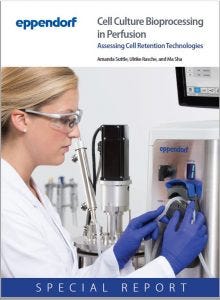- Sponsored Content
- Perfusion Cell Culture
Cell Culture Bioprocessing in Perfusion: Assessing Cell Retention TechnologiesCell Culture Bioprocessing in Perfusion: Assessing Cell Retention Technologies
Sponsored by Eppendorf
 Upstream bioprocessing in perfusion mode holds great promise for industrial production of cells and biologics. In perfusion, fresh medium is added constantly to the bioreactor, and used medium is harvested while the cells are retained in the bioreactor. As a result, the composition of the cell culture medium stays quite constant during the process. This offers several advantages. In perfusion, higher cell densities can be reached than in batch and fed-batch processes, therefore enhancing volumetric productivity. Because medium composition can influence cell metabolism and therefore product characteristics, the more constant the process conditions, the more consistent may be the product quality. Products that pass through the cell retention device are constantly harvested. The time they reside in the culture medium is reduced from that of a fed-batch culture, which is advantageous for production of less-stable products.
Upstream bioprocessing in perfusion mode holds great promise for industrial production of cells and biologics. In perfusion, fresh medium is added constantly to the bioreactor, and used medium is harvested while the cells are retained in the bioreactor. As a result, the composition of the cell culture medium stays quite constant during the process. This offers several advantages. In perfusion, higher cell densities can be reached than in batch and fed-batch processes, therefore enhancing volumetric productivity. Because medium composition can influence cell metabolism and therefore product characteristics, the more constant the process conditions, the more consistent may be the product quality. Products that pass through the cell retention device are constantly harvested. The time they reside in the culture medium is reduced from that of a fed-batch culture, which is advantageous for production of less-stable products.
Apart from being used for production of secreted proteins or viral vectors, perfusion may be used for the earlier substeps of some bioprocesses, as in production of high-density seed trains or to achieve high cell densities before transfection/infection of cells for viral vector production. In all cases, perfusion bioprocessing requires a cell retention device within or attached to the bioreactor. The choice of retention technology depends on whether adherent or suspension cells are cultivated; whether a soluble protein, a virus, or the cells themselves are the product of interest; whether the product needs to be harvested continuously; whether the process needs to be scalable; and other factors.
In proof-of-concept studies, we have connected Eppendorf bioreactors to different cell retention devices. We equipped Eppendorf bioprocess systems with an alternating–tangential-flow (ATF) filtration device, a packed-bed basket impeller, or a microcarrier spin filter. We assessed the suitability of each system for mammalian cell culture in perfusion and evaluated its scalability.
Just fill out the form below to read this special report now.
You May Also Like





